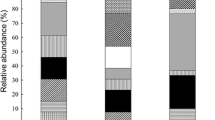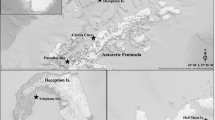Abstract
Seaweed epiphytic bacteria are highly host specific and their association is little known. The marine environment of Andaman Islands is rich in algal diversity and their association with microbial communities remains unexplored. We investigated the epiphytic bacterial communities from the intertidal red alga Gracilaria canaliculata. A total of four epiphytic bacterial isolates were cultured and screened for antimicrobial activity. Of the four isolates, one potential isolate, Gr102, exhibited strong antimicrobial activity in 0.50 μg/ml concentration against enteropathogenic Escherichia coli, Klebsiella pneumoniae, and Shigella flexneri. This potential isolate was characterized by genomic sequencing, fatty acid methyl ester analysis, and matrix-assisted laser desorption ionization-time of flight spectrometry, and the strain Gr102 was identified as Lysinibacillus odysseyi KC149512. Purified fractions obtained were analyzed by gas chromatography and mass spectrometry. Antimicrobial compounds such as furan, lupenol, diazene, and butenyl methyl ketone were identified. Based on the high level of activity, red algae epiphytic bacteria are potential sources of producing bioactive secondary metabolites.





Similar content being viewed by others
References
Zheng L, Han X, Chen H, Lin W, Yan X (2005) Marine bacteria associated with marine macro organisms: the potential antimicrobial resources. Ann Microbiol 55:119–124
Wahl M (2008) Ecological lever and interface ecology: epibiosis modulates the interactions between host and environment. Biofouling. 24:427–438
Goecke F, Thiel V, Wiese J, Imhoff LA (2013) Algae as an important environment for bacteria phylogenetic relationships among new bacterial species isolated from algae. Phycologia 52:14–24
Kanagasabhapathy M, Sasaki H, Haldar S, Yamasaki S, Nagata S (2006) Antibacterial activities of marine epibiotic bacteria isolated from brown seaweeds of Japan. Ann Microbiol 56:167–173
Ali IB, Bour ME, Ktari L, Bolhuis H, Ahmed TM, Boudabbous A, Stal LJ (2012) Jania rubens-associated bacteria: molecular identification and antimicrobial activity. J Appl Phycol 24:525–534
Singh RP, Bijo AJ, Baghel RS, Reddy CRK, Jha B (2011) Role of bacterial isolates in enhancing the bud induction in the industrially important red alga Gracilaria dura. FEMS Microbiol Ecol 76:392
Kumar V, Rao D, Thomas T, Kjelleberg S, Egan S (2011) Antidiatom and antibacterial activity of epiphytic bacteria isolated from Ulva lactuca in tropical waters. World J Microbiol Biotechnol 27:1543–1549
Rao D, Webb JS, Holmstr C, Case R, Low A, Steinberg P, Kjelleberg S (2007) Low densities of epiphytic bacteria from the marine alga Ulva australis inhibit settlement of fouling organisms. Appl Environ Microbiol 73:7844–7852
Ma Y, Liu P, Yu S, Li D, Cao S (2009) Inhibition of common fouling organisms in mariculture by epiphytic bacteria from the surfaces of seaweeds and invertebrates. Acta Ecol Sin 29:222–226
Egan S, Thomas T, Kjelleberg S (2008) Unlocking the diversity and biotechnological potential of marine surface associated microbial communities. Curr Opin Microbiol 11:225
Susilowatia R, Sabdonob A, Widowati I (2015) Isolation and characterization of bacteria associated with brown algae Sargassum spp from Panjang Island and their antibacterial activities. Procedia Environ Sci 23:240–246
Karthick P, Mohanraju R, Murthy KN, Ramesh CH, Narayana S (2013) Seaweed potential of Little Andaman. Seaweed Res Utilin 35:17–21
Murthy KN, Karthick P, Mohanraju R, Ramesh CH, Narayana S (2013) Epiphytic Vibrios from the seaweeds of Andaman Islands India. Seaweed Res Utilin 35:220–225
Karthick P, Mohanraju R, Murthy KN, Ramesh CH (2014) Antibacterial activity of seaweeds collected from South Andaman India. J Algal Biomass Utiln 6:33–36
Lemos ML, Toranzo AE, Barja JL (1985) Antibiotic activity of epiphytic bacteria isolated from intertidal seaweeds. Microb Ecol 11:149–163
Pridham TG, Gottlieb D (1948) The utilization of carbon compounds by some Actinomycetales as an aid for species determination. J Bacteriol 56:107–114
Karthick P, Mohanraju R (2018) Antimicrobial potential of epiphytic bacteria associated with seaweeds of Little Andaman India. Front Microbiol 9:1–11. https://doi.org/10.3389/fmicb201800611
Sasser M (1990) Identification of bacteria by gas chromatography of cellular fatty acids MIDI Technical Note 101 Newyork DE: MIDI Inc.
Mohandass C, Rajasabapathy R, Ravindran C, Colaco A, Santos RS, Meena RM (2012) Bacterial diversity and their adaptations in the shallow water hydrothermal vent at D Joao de Castro Seamount (DJCS) Azores Portugal. Cah Biol Mar 53:65–76
Lane DJ (1991) 16S/23S rRNA sequencing. In: Stackebrandt E, Goodfellow M (eds) Nucleic acid techniques in bacterial systematics. John Wiley & Sons Inc, New York, pp 115–175
Ashelford KE, Chuzhanova NA, Fry JC, Jones AJ, Weightman AJ (2005) At least 1 in 20 16S rRNA sequence records currently held in public repositories is estimated to contain substantial anomalies. Appl Environ Microbiol 71:7724–7736
Thompson JD, Gibson TJ, Plewniak F, Jeanmougin F, Higgins DG (1997) The Clustal X windows interface: flexible strategies for multiple sequence alignment aided by quality analysis tools. Nucleic Acids Res 24:4876–4882
Tamura K, Dudley J, Nei M, Kumar S (2007) MEGA4: Molecular Evolutionary Genetics Analysis (MEGA) software version 40. Mol Biol Evol 24:1596–1599
Tamura K, Nei M, Kumar S (2004) Prospects for inferring very large phylogenies by using the neighbor-joining method. Proceedings of the National Academy of Sciences (USA) 11030–11035
Duc La M, Satomi M, Venkateswaran K (2004) Bacillus odysseyi sp Nov a round- spore- forming bacillus isolated from the Mars Odyssey Spacecraft. Int J Syst Evol Microbiol 54:195–201
Tambekar SD, Tambekar DH (2012) Physico-chemical properties and production dynamics of alkaline protease of Bacillus odysseyi (JQ337959) isolated from Lonar lake. Int J Adv Pharm Biol Sci 2:161–170
Wiese J, Thiel V, Nagel K, Staufenberger T, Imhoff JF (2009) Diversity of antibiotic-active bacteria associated with the brown alga Laminaria saccharina from the Baltic Sea. Mar Biotechnol 11:287–230
Jayanth K, Jeyasekaran G, Shakila RJ (2002) Isolation of marine bacteria antagonistic to human pathogens. Indian J Mar Sci 31:45–51
Karthick P, Mohanraju R, Murthy KN, Ramesh CH, Mohandass C, Rajasabapathy R, Vellai Kumar S (2015) Antimicrobial activity of Serratia sp isolated from the coralline red algae Amphiroa anceps. Indian J Geo Mar Sci 44(12):1857–1866
Jaruchoktaweechai C, Suwanborirux K, Tanasupawatt S, Kittakoop P, Menasveta P (2000) New macrolactins from a marine Bacillus sp Sc026. J Nat Prod 63:988–998
Barsby T, Kelly MT, Gagne SM, Andersen RJ (2001) Bugorol A produced in culture by a marine Bacillus sp reveals a novel template for cationic peptide antibiotics. Org Lett 3:437–440
Hentschel U, Schmid M, Wagner M, Fieseler L, Gernert C, Hacker J (2001) Isolation and phylogenetic analysis of bacteria with antibacterial activities from the Mediterranean sponge Aplysina aerophoba and Aplysina cavernicola. FEMS Microbial Ecol 35:305–312
Baruzzi F, Quintieri L, Morea M, Caputo L (2011) Antimicrobial compounds produced by Bacillus spp and applications in food science against microbial pathogens: communicating current research and technological advances (Edt AMendez Vilas) 1102-1111
Kanagasabapathy M, Sasaki H, Nagata S (2008) Phylogenetic identification of epibiotic bacteria possessing antimicrobial activities isolated from red algal species of Japan. World J Microbiol Biotechnol 24:2315–2321
Kuta FA, Nimzing L, Orkaa PY (2009) Screening of Bacillus species with potentials of antibiotics production. App Med Inf 24:46
Berdy J (1989) The discovery of new bioactive microbial metabolites: screening and identification. In: Bushell ME, Grafe U (eds) Bioactive metabolites from microorganisms. Elsevier Science Publications, Amsterdam
Ishihara H, Takoh M, Nishibayashi R, Sato A (2002) Distribution and variation of bacitracin synthetase gene sequences in laboratory stock isolates of Bacillus licheniformis. Curr Microbiol 45:18–23
Crisley FD (1964) Antibacterial interaction between bromothymol blue and polymyxin B. Nature 203:211–213
Jafarzade M, Yahiya NA, Shayesteh F, Usup G, Ahmad A (2013) Influence of culture conditions and medium composition on the production of antibacterial compounds by marine Serratia sp. WPRA3. J Microbiol 51:373–379
Wang J, Zhang H, Yang X, Zhou Y, Wang H, Bai H (2008) HS071 a new furan-type cytotoxic metabolite from Streptomyces sp HS-HY-071. J Antibiot 61:623–626
Ding LJ, Gu BB, Jiao WH, Yuan W, Li YX, Tang WZ, Yu HB, Liao XJ (2015) New furan and cyclopentanone derivatives from the sponge associated fungus Hypocrea koningii PF04. Mar Drugs 13:5592
Khumalo GP, Sadgrove NJ, Van VSF, Van WBE (2019) Antimicrobial lupenol triterpenes and a polyphenol from Elaeodendron transvaalense a popular southern African medicinal bark. S Afr J Bot 122:518–521
Dembitsky VM, Gloriozova TA, Poroikov VV (2017) Pharmacological and predicted activities of natural azo compounds. Nat Prod Bioprospect 7:151–169
Sankpal SA, Deshmukh MB, Anbhule PV, Salunkhe DK, Alsundkar KN, Patil PP (2010) Synthesis and antibacterial evaluations of (35-dimethyl-1H-pyrazol-4-yl)-phenyl-diazenes. J Chem Pharm Res 2:574–579
Acknowledgments
This work is a part of the Ph.D. thesis of the first author. The authors thank the Pondicherry University authorities for providing the facilities. Thanks to Dr. Anas Abdul Aziz, scientist, MMRF, NIO (RC), Cochin, for permitting the laboratory facilities. Also, thanks to Mr. Craig Kunitsky, MIDI, Laboratories, Newark, USA, for analyzing MALDI-TOF in this study.
Author information
Authors and Affiliations
Corresponding author
Ethics declarations
Competing interests
The authors declare that they have no conflicts of interest.
Additional information
Responsible Editor: Fernando R. Pavan.
Publisher’s note
Springer Nature remains neutral with regard to jurisdictional claims in published maps and institutional affiliations.
Rights and permissions
About this article
Cite this article
Karthick, P., Mohanraju, R. Antimicrobial compounds produced by Lysinibacillus odysseyi epiphytic bacteria associated with red algae. Braz J Microbiol 51, 1683–1690 (2020). https://doi.org/10.1007/s42770-020-00341-x
Received:
Accepted:
Published:
Issue Date:
DOI: https://doi.org/10.1007/s42770-020-00341-x




